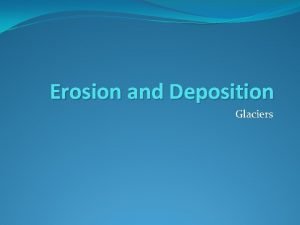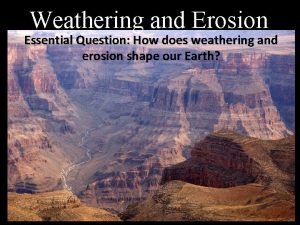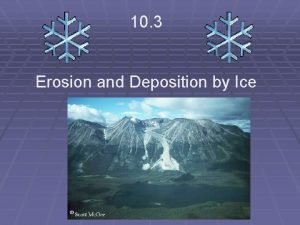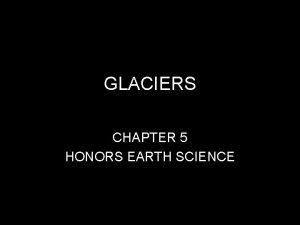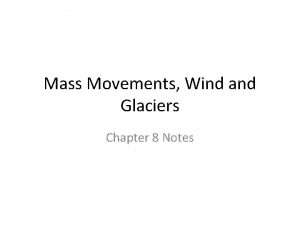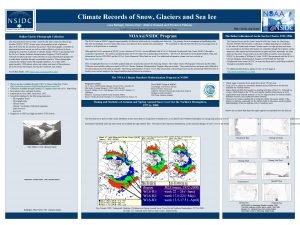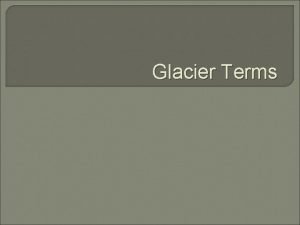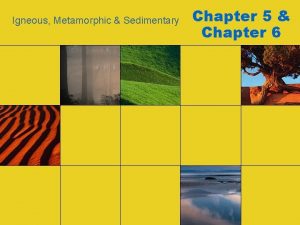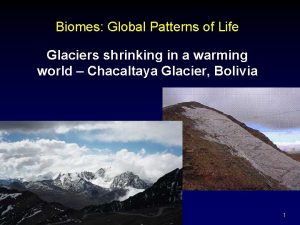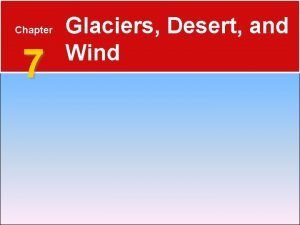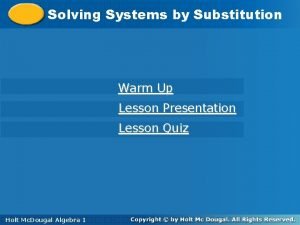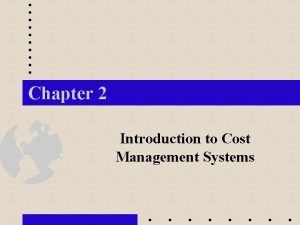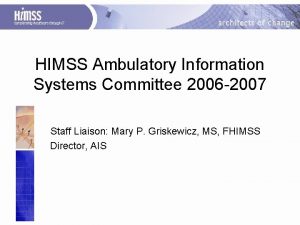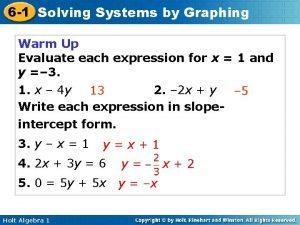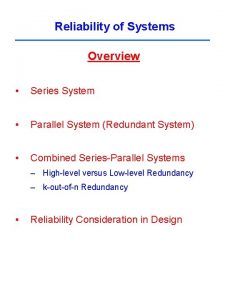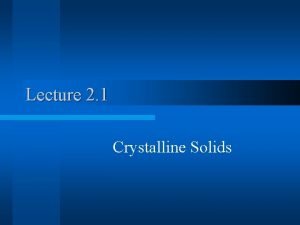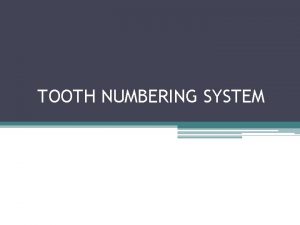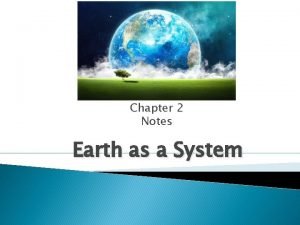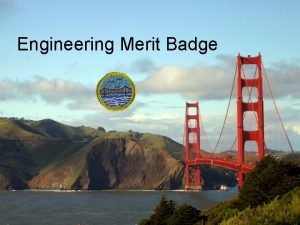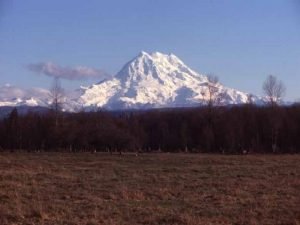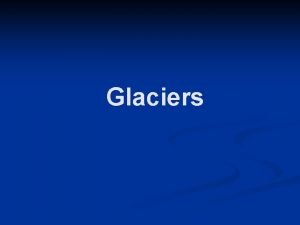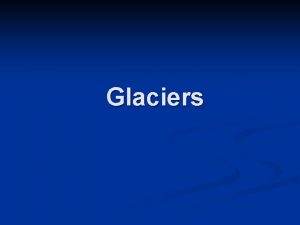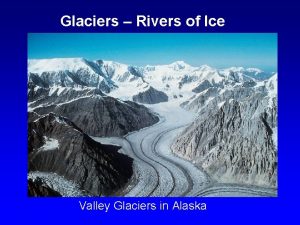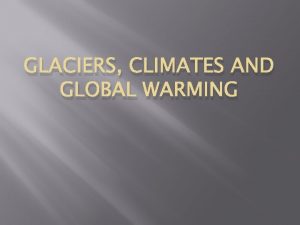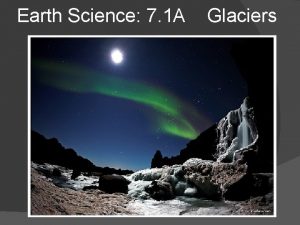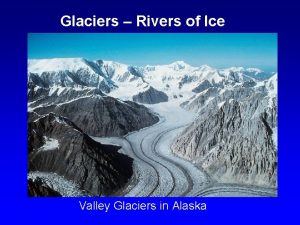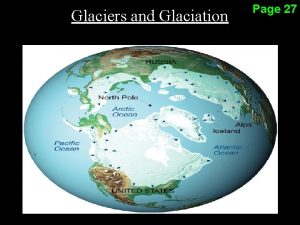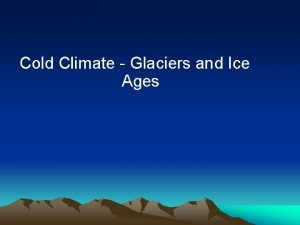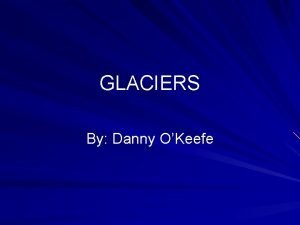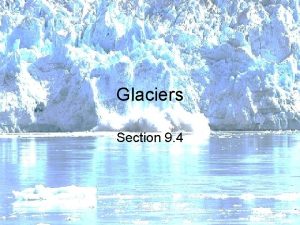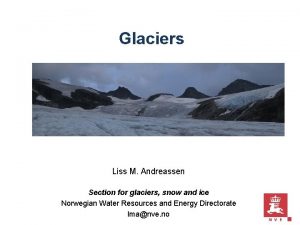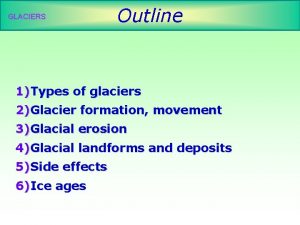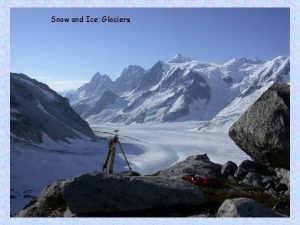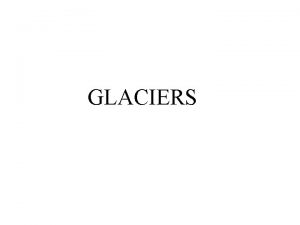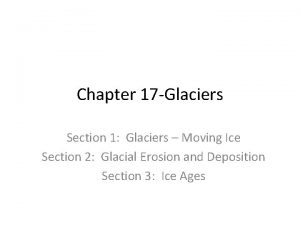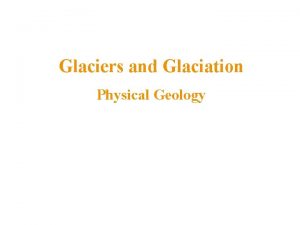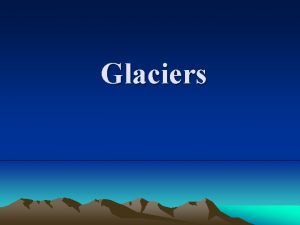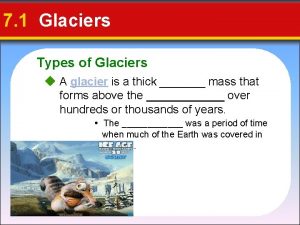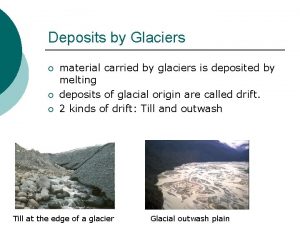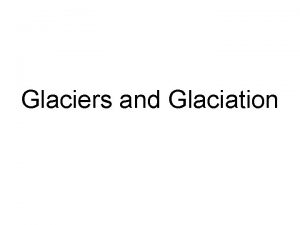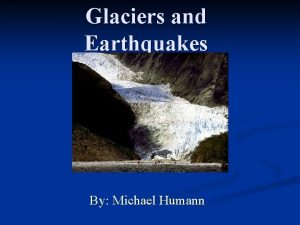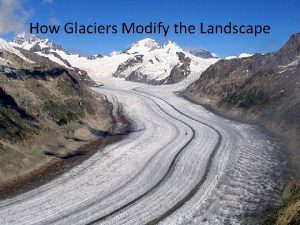GLACIERS What Are Glaciers glaciers are systems of










































- Slides: 42

GLACIERS What Are Glaciers? • glaciers are systems of ice originating on land through the accumulation and recrystallization of snow

• 3 types of glaciers 1. valley glaciers (alpine) i. originates high on a mountain and moves downward through preexisting valleys

3 types of glaciers 1. valley glaciers (alpine) ii. cirque glaciers are special types of valley glaciers that occupy an erosional feature that is cut into bedrock and is bowl shaped (cirque)

• 3 types of glaciers 2. continental glaciers i. a slow-moving ice sheet that resembles a giant dome several thousand meters thick in the center and sloping down toward sea level on all sides


• 3 types of glaciers 3. piedmont glaciers i. found at the foot of a mountain ii. occur when valley glaciers come out of mountains and join at the foot of a mountain

How Do Glaciers Form? • glaciers form in areas where winter snowfall exceeds summer melting - zone of accumulation 1. does not require year-round snowfall, only cold enough to have snow exist through the summer

How Do Glaciers Form? 2. the weight of accumulating snow compress lower layers into glacial ice i. snow ii. granular ice iii. firn iv. glacial ice

How Do Glaciers Form? 3. as the ice accumulates, it begins to flow

How Do Glaciers Form? • the glacier also loses ice - zone of ablation 1. melting

How Do Glaciers Form? • the glacier also loses ice - zone of ablation 2. calving 3. sublimation

Glacial Budgets

How Do Glaciers Move? • ice flow due to: 1. basal sliding - due to base of glacier being wet

How Do Glaciers Move? • ice flow due to: 2. creep (plastic flow) - due to gravity

How Do Glaciers Move? • ice flow due to: 3. crevasses

• patterns of flow 1. valley glaciers vs. continental glaciers

How Do Glaciers Move Sediments? • very different from any other type of sediment movement 1. no differentiation of size of material i. boulders to rock flour 2. when material is deposited it is unsorted and unstratified 3. Glacial Drift: any material that is deposited by glaciers i. till ii. stratified drift


The Features of Glacier Systems • Continental Glaciers 1. striations

The Features of Glacier Systems • Continental Glaciers 2. erratics

The Features of Glacier Systems • Continental Glaciers 3. drumlins

The Features of Glacier Systems • Continental Glaciers 4. eskers

The Features of Glacier Systems • Continental Glaciers 5. kettle lakes

The Features of Glacier Systems • Continental Glaciers 6. 7. moraines i. ground moraine ii. terminal (or end) moriane (terminus) iii. recessional moraine outwash plain



• Valley Glacier: U-shaped valleys 1. aretes

• Valley Glacier: U-shaped valleys 2. cirque 3. horn


• Valley Glacier: U-shaped valleys 4. hanging valley

• Valley Glacier: U-shaped valleys 5. truncated spurs

• Valley Glacier: U-shaped valleys 6. terminus 7. moraines i. lateral moraine ii. medial moraine


Pleistocene Ice Age (3 million years ago) • four separate glacial advances 1. Holocene Interglacial (current - 10, 000) 2. Wisconsinan Glaciation (200, 000 -18, 000 ya) 3. Sangamon Interglacial 4. Illinoian Glaciation(550, 000 - 400, 000 ya) 5. Yarmouth Interglacial 6. Kansan Glaciation (1, 400, 000 - 950, 000) 7. Aftonian Interglacial 8. Nebraskan Glaciation (2, 200, 000 mya - 1, 750, 000 ya)

Why Did Ice Age Occur? • the amount of solar energies varies and when the earth moves it gets less energy • only need to lower temperatures by 6 F and we would be in another ice age

UPDATE: APRIL 1999 • Loss of Antarctic Ice Sheet 1. "It was nearly as much activity in a single year as we've seen in 10 or 15 years up to now on average" 2. "To have retreats totaling 3, 000 square kilometers in a single year is clearly an escalation" 3. "Within a few years, much of the Wilkins ice shelf will likely be gone. "

UPDATE: Nov. 2002 “The leaders of Tuvalu—a tiny island country in the Pacific Ocean midway between Hawaii and Australia—have conceded defeat in their battle with the rising sea, announcing that they will abandon their homeland. ” “During the twentieth century, sea level rose by 20 -30 centimeters (8 -12 inches). The Intergovernmental Panel on Climate Change projects a rise of up to 1 meter during this century. Sea level is rising because of the melting of glaciers and thermal expansion of the ocean as a result of climate change. ”

• Risks involved with sea level rise 1. Over 1/2 of the human population lives within 100 km of the sea 2. 20% of the human population lives in areas that would be "drowned" by a sea level increase of 1 m 3. Over 40 million people are currently subject to storm surge flooding 4. Predicted risks with sea level rise i. Drowning of cities and farm lands ii. Incursion of salt water iii. Increased risk of damage from violent storm (hurricanes)




 Antigentest åre
Antigentest åre Glaciers
Glaciers Glaciers cause erosion by abrasion and
Glaciers cause erosion by abrasion and Glacial drift vs till
Glacial drift vs till Morraine glacier
Morraine glacier Arrowhead region mn
Arrowhead region mn Examples of mass movement
Examples of mass movement Nsidc glaciers
Nsidc glaciers Glacier terms
Glacier terms Angular sedimentary rocks
Angular sedimentary rocks Bolivia glaciers
Bolivia glaciers Chapter 7 glaciers deserts and wind
Chapter 7 glaciers deserts and wind Decision support systems and intelligent systems
Decision support systems and intelligent systems Engineering elegant systems: theory of systems engineering
Engineering elegant systems: theory of systems engineering Principles of complex systems for systems engineering
Principles of complex systems for systems engineering Embedded systems vs cyber physical systems
Embedded systems vs cyber physical systems Personal response systems
Personal response systems Manufacturing systems modeling and analysis
Manufacturing systems modeling and analysis Solving systems of equations by substitution activity
Solving systems of equations by substitution activity Advanced operating system notes
Advanced operating system notes Pe systems pvt ltd
Pe systems pvt ltd Cost control systems
Cost control systems Msi logic
Msi logic Ambulatory information systems
Ambulatory information systems Instrumentation ppt
Instrumentation ppt Solve the system by graphing
Solve the system by graphing Esl power systems jobs
Esl power systems jobs Marketing information systems and marketing research
Marketing information systems and marketing research Pic architecture diagram
Pic architecture diagram Embeded systems design
Embeded systems design Reliability of series and parallel systems example
Reliability of series and parallel systems example Seven samurai of systems engineering
Seven samurai of systems engineering Crystal systems
Crystal systems Dental formula of deciduous teeth
Dental formula of deciduous teeth Earth's spheres foldable
Earth's spheres foldable This is the final task in phase 3 systems design
This is the final task in phase 3 systems design Kendall and kendall system analysis and design
Kendall and kendall system analysis and design Functional area information systems adalah
Functional area information systems adalah Information system in global business today
Information system in global business today Engineering merit badge
Engineering merit badge Lubrication and cooling system
Lubrication and cooling system Terrestrial food production
Terrestrial food production Cyber power solutions
Cyber power solutions

